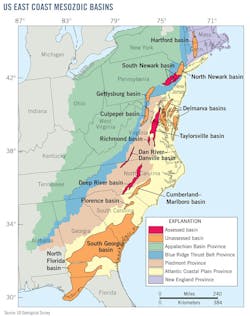Five basins on the US East Coast contain an estimated mean undiscovered natural gas resource of nearly 3.9 tcf and a mean undiscovered natural gas liquids resource of 135 million bbl in continuous accumulations, the US Geological Survey said in a recent assessment.
USGS assessed five Mesozoic rift basins: the Deep River, Taylorsville, South Newark, Dan River-Danville, and Richmond basins.
The Deep River, Dan River-Danville, and Richmond basins are within the Piedmont Province of North Carolina and Virginia. The Taylorsville basin is almost entirely within the Atlantic Coastal Plain Providence of Virginia and Maryland. The South Newark basin is within the Blue Ridge Thrust Belt Province of New Jersey.
The provinces, which contain these extensional basins, extend across parts of Georgia, South Carolina, North Carolina, Virginia, Maryland, Delaware, Pennsylvania, New Jersey, New York, Connecticut, and Massachusetts.
The term Mesozoic describes basins formed in middle Carnian (Late Triassic) some 227 million years ago.
All accumulations assessed by the recent USGS study are tight gas sandstone reservoirs. USGS said 14 major East Coast Mesozoic rift basins exist onshore and offshore, but there were only enough data for assessment of five.
Of the five basins, USGS said three appear to have the potential to produce the most hydrocarbons. Those three are the Deep River in North Carolina, the Taylorsville primarily in Virginia and southern Maryland, and the South Newark in New Jersey and Pennsylvania.
Exploration target for decades
Industry has contemplated the Mesozoic basins of the East Coast since the 1980s. The USGS report was released in June coming while lawmakers in North Carolina and elsewhere considered regulations for hydraulic fracturing and horizontal drilling.
"The source rocks for oil and gas within the Mesozoic basins include gray and black shales and the coal beds," USGS said. "The shales accumulated in nearshore deltas, in interdistributary bays, and in the deeper portions of the lakes that occupied the basins."
Black shale beds can range in thickness from a few feet to several hundred feet, USGS said.
"Kerogen in these beds generally consists of material derived from vascular plants and algae, which are the types of kerogen that are prone to yield both gas and oil," the East Coast Mesozoic Basin Assessment Team said.
The USGS report was entitled "Assessment of Undiscovered Oil and Gas Resources of the East Coast Mesozoic Basins of the Piedmont, Blue Ridge Thrust Belt, Atlantic Coastal Plain, and New England Provinces."
Information about the assessment and its methodology can be found at the USGS web site: http://energy.usgs.gov.

